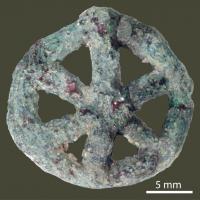Copy Link
Add to Bookmark
Report
Delaware Valley Rail Passenger Vol 13 No 02

The Delaware Valley Rail Passenger
February 1995
Vol. XIII, No. 2
ISSN 1073-6859
Published by the Delaware Valley Association of Railroad Passengers in the
interest of continued, improved, and expanded rail service for the present
and potential railroad and rail transit passengers of southeastern
Pennsylvania, southern New Jersey, and nearby areas.
For more information about DVARP and good rail service, please contact us:
P.O. Box 7505, Philadelphia, PA 19101 215-222-3373 <dvarp@libertynet.org>
Schedule change alert: New SEPTA R8 and R5 Doylestown schedules are in
effect. Some Amtrak long-distance trains were reduced in frequency (see
page 10) SEPTA City Transit schedules change February 5.
Inside The Delaware Valley Rail Passenger...
1 SEPTA Board delays vote on Newtown shuttle after DVARP questions
its effectiveness.
DVARP restructuring brings new officers and a new way of doing
business.
3 DVARP gets a partial win on SEPTA fare proposal, even though it
wasn't in on the deal.
Clinton Admin., House Republicans considering folding Amtrak $$$
into block grants.
5 On the Railroad Lines: Houstoun, Wooten join Ridge admin.;
Overbrook Shop opens
6 Transit News Update: CTD contract battle underway;
Center City trolley to start April.
7 Commuter rail expansion stories around the country;
Whitman: no NJT fare hike.
8 DVARP's own place on the internet: check it out!
10 Amtrak News: New Maine and Carolina trains will not be cut;
NY-Albany speed-up.
11 Up and Down the Corridor: Amtrak notices MARC's success,
hires their boss.
13 DVARP praised in Bucks news article
14-15 Volunteer Opportunities,
Dates of Interest,
DVARP Directory,
Membership renewal
DVARP President: Donald Nigro Newsletter Editor: Matthew Mitchell
for other officers and committee chairs, see page 15
entire contents copyright (c) 1995 DVARP, except photos (c) 1995 credited
photographers
Opinions expressed in The Delaware Valley Rail Passenger are not necessarily
those of DVARP or its members. We welcome your comments: call 215-222-3373
Board Applies Brakes to Newtown Bungle
by Don Nigro
The SEPTA Board announced at its January 26 meeting that it would give
"further consideration" to the Newtown service restoration project before it
is added to the Capital Budget for Fiscal 1995. The project, as conceived
by some within the SEPTA staff, would involve a shuttle service on the outer
9 miles of the 15 mile Fox Chase-Newtown rail line, connecting through onto
the Conrail Morrisville Line for two miles to a point at SEPTA's Warminster
Line where passengers would transfer at a proposed $8.6 million bi-level
station to R2 trains. The $32 million capital investment with its proposed
eighteen round trips per weekday would have relatively minimal ridership and
would require 77 minutes travel time between Newtown and Center City.
At the SEPTA Board meeting, DVARP President Donald Nigro applauded the
decision to closely examine staff's ineffective and costly Newtown service
restoration plans. Indeed, the system worked as it should. As Nigro stated
at the meeting, "the grave concerns expressed by DVARP, Newtown Township and
other bodies were heard by this Board."
Three days before the Board meeting, DVARP hand-delivered the following
letter to Thomas Hayward, Chairman of SEPTA's Board.
January 22, 1995
Dear Mr. Hayward:
DVARP is appalled at the secrecy, reckless haste, and disregard for the
interests of passengers and taxpayers alike in SEPTA staff's handling in the
past two months of the Newtown service restoration matter.
Staff summarily chose to back what demonstrably is the worst and weakest of
all service plans offered to date. Most recently, it all but rejected a
private operator's plan which would have cost SEPTA and the public
relatively little. Now we have been "set up" for a $32 million construction
project, a plan that is about 60% more costly than any plan offered
previously.
continued on page 12
DVARP Reorganizes by Matthew Mitchell New Board is Installed at
January Meeting
The nine-member Board of Directors elected by DVARP members in December took
office at the DVARP meeting last month. The Board then immediately tackled
a full slate of important issues, fulfilling the role envisioned by the
proponents of the reorganization.
Prior to the meeting, Chuck Bode announced his intention to resign the
presidency, so the new Board's first order of business was the unanimous
election of Don Nigro as the new president. Bode had served in the office
for nearly three and one-half years, and saw the
continued on page 13
From the Editor's Seat: The Fare Deal
While the outcome of the public decision-making process of how SEPTA's fares
should be increased was about as good as could be expected (DVARP asked for
the transfer charge to be rolled back to a quarter), we have some problems
with how SEPTA's Board and staff got there.
Three examples illustrate what we talked about in a DVARP letter to Tom
Hayward and Lou Gambaccini: in the days leading up to the Board meeting in
which the fare package was voted on, Board Members Jettie Newkirk and Dick
Voith (both Philadelphia appointees) negotiated the terms of it with a few
special interest groups. After the increase was approved, the city and
SEPTA worked out a token deal with the public and parochial schools. And a
few weeks before the public hearings, DVARP President Chuck Bode met with
John McGee, the Revenue Development officer responsible for structuring the
fare proposal, to exchange views.
While these all are good examples of communication between SEPTA and
interested outsiders, and Newkirk and Voith deserve commendation for their
efforts to make sure the Board really does act in the public interest, the
fare deal crossed the line between letting the people have a say in public
policy and a bad backroom deal, because only a select few groups got this
special treatment. Everyone else had to go through the public hearing
process.
A lot more people got constructively involved in the process than were were
represented in that back room. The Citizen Advisory Committee (Voith served
on it), exists precisely to represent all of SEPTA's riders. Why weren't
they the key players in this deal?
It set a bad precedent. Do we really want democracy to be a contest of who
can yell loudest in front of the TV cameras?
Glad to be Back
I appreciate the kind words spoken by the DVARP Board members who last month
invited me back to edit this newsletter. I hope to live up to their
expectations and yours. For a dozen years, the DVRP has been a cornerstone
of this organization, and has done as much as anything to build our
reputation for delivering rational and unbiased views on transportation
issues.
Chuck Bode, Don Nigro, and Bob Machler deserve high praise for all the work
they did to get The Delaware Valley Rail Passenger to you the past four
months, while DVARP's future was being resolved. They took on the big
responsibility with no complaints, and they did a great job despite the
distractions.
And I'm glad to be back in another way too: back home full-time in the
Delaware Valley for good after a year commuting weekly to the Washington
area--MDM
Board Approves Fare Hike with Last-Minute Change
SEPTA fares increased an average of seven percent last month, after a late
revision to management's proposed transit tariffs. A ten-cent increase in
the cash base fare replaced the ten-cent increase in the transfer charge
after negotiations between SEPTA and several fare increase opponents on the
eve of the Board meeting in which the fares were to be considered.
But the dealing wasn't over. In the days before the fare increase went into
effect, the Rendell Administration helped several top SEPTA staffers
negotiate a deal with the School District and with the Archdiocese of
Philadelphia so they could acquire the tokens they needed for the rest of
the school year at the old price. SEPTA held firm on its insistence that
added subsidies for school to kens were the responsibility of the schools,
but gave the schools a short extension on paying for the tokens they ordered
before the fare increase went into effect. An anonymous benefactor helped
the Catholic schools obtain a loan for their tokens.
This fare increase came with much less controversy than the increases of
five and six years ago. Attendance was less than expected at most of the
public hearings. Opposition to the fares came mostly from well-orchestrated
groups rather than a ground swell of public concern. The long period since
the previous increase, the modest size of the increase, and the trend of
improving rather than declining service turned opposition to SEPTA's
proposal into grudging acceptance. In the best of all possible worlds,
Federal and state governments would raise their subsidies of SEPTA's
operating budget, but most observers agreed with DVARP that such an ending
was very unlikely, and a fare increase was the lesser of two evils when
compared to service cuts.--MDM
Clinton, House Seek Big Policy Changes: Could This be the End of Amtrak?
by Matthew Mitchell
Recent actions in Washington presage a major change in how the Federal
government supports intercity rail service. Both Republicans in the House
of Representatives and the Clinton Administration propose to zero-out direct
support for Amtrak in the Federal budget.
House bill H.R. 259, introduced by Joel Hefley (R-CO) and having ten
Republican co-sponsors as of this writing, paves the way for elimination of
Amtrak, though it is couched in the language of 'making Amtrak more
competitive.' Besides pha-sing out all Federal support of the railroad over
five years, the bill includes provi-sions removing obstacles to service
elimi-nations, most notably Federal labor pro-tection laws which obligate
railroads to guarantee up to six years' wages to employees losing their jobs
as a result of service abandonments.
While Rep. Robert Walker (R-PA) holds a high post in the House Republican
leadership, the serious cuts to the Keystone trains many of his
constituents ride has caused him to break ranks with his colleagues and
oppose Amtrak's elimination. It is yet to be seen whether this conversion
goes so far as support of continued Federal operating funding. Senate
Republicans also have been cool to the idea of killing Amtrak, so changes
to the House bill could be seen before final passage.
The full text of the bill is available from DVARP by sending us a $1.00 for
copying and postage, or on-line at:
http://libertynet.org/~dvarp/docs/hr259.txt
Meanwhile, the Clinton Administra-tion's plan for restructuring the
Depart-ment of Transportation calls for replacing direct funding of Amtrak
and other trans-portation programs with block grants to the states. State
and local officials would then determine whether to purchase service from
Amtrak with the money or apply it to highways, public transit, or other
ends.
The de-Federalization plan for DOT has not received much media attention,
unlike the analogous proposal to combine all public welfare plans into a
single block grant to the states. The problems and opportunities of the
proposal haven't been discussed. But the consequences would be at least as
great as the welfare changes. Every citizen has a stake in the
effectiveness of the transportation system; in safety, opportunity to live
and work where they wish, its effect on the form of our cities and towns,
air pollution, dependence on foreign energy (and the wars fought to protect
it), and many more areas.
Combination of mode-specific grants into "flexible" funding has been a
success. In theory, local officials have a better grasp of local
transportation needs, and should be able to allocate resources to meet those
needs. The Clinton plan takes that to the limit, making all DOT funds
flexible. But it fails to solve the biggest problem of public policy in
transportation, the hidden subsidies of roads, aviation, waterways, and
other competing modes. Neither Clinton nor the sponsors of H.R. 259 address
these subsidies, which have a much larger impact on the Federal deficit.
Shuster: Cut Amtrak, Don't Kill It
As he took the chairmanship of the House Transportation and Infrastructure
Committee, Rep. Bud Shuster (R-PA) had harsh words to say about Amtrak:
"Amtrak is on a life support system. It's a disaster." He wants for Amtrak
to further cut costs and reduce its need for Federal funding, but opposed
closing the railroad altogether, in part because his state ben-efits greatly
from it. Shuster also called for a shift in Amtrak's support from the
Federal government to the states, and supported a national route system
rather than retrenchment to a few busy corridors.
Amtrak spokesman Clifford Black responded cautiously, promising Amtrak would
work with Shuster. But he made clear that privatization of Amtrak was no
solution, as no business could make a profit running Amtrak if it were the
only unsubsidized transportation mode.--MDM
Supporters of the House bill would like to see the private sector take over
Amtrak. But unlike the Post Office to which it is philosophically compared,
Amtrak already behaves like a private-sector company. It can set services
and fares without government interference, and is not subject to ridiculous
levels of regulation.
Privatization isn't likely to bring much improvement to the
already-"commercialized" railroad, which is one of the reasons why
prospective private operators are not stepping forward to buy Amtrak.
Another reason is the vast subsidies to competing modes, and Congress's
inability to recognize them and level the playing field.
A Senate hearing on Amtrak held late last month gave some hope that
elimination of Amtrak isn't a done deal. All the Senators who spoke
supported the continued existence of a nationwide passenger rail network;
not one supported the gutting of Amtrak. Several felt that the cuts
announced already go too far.
Regional splits
The blows to Amtrak of the past two months have created fissures among
supporters of passenger rail service. Some backers of the House bill
believe that the Northeast Corridor could be a profitable private
enterprise if the money-losing long-distance portion of the Amtrak route
system were abandoned. But others reply that it is the Corridor that is
absorbing all the Federal subsidies, and the long-distance routes should be
given a chance to make it on their own. The shift in internal accounting
policies evident in Tom Downs's selection of services to be cut this month
and in April makes it even harder to determine which, if either, side is
right. Which part of Amtrak is more profitable depends a lot on how you
allocate costs and revenues. NARP, DVARP, and most of their peers hold the
view that neither segment can survive alone, either economically or
politically.
With services to Harrisburg and Atlantic City already up for elimination
April 1 regardless of the status of the Clinton plan or H.R. 259, changes in
the landscape are assured. State takeovers of the services are a strong
possibility. They have been hinted at in New Jersey, while California has
already stepped in with funding to retain the Capitols service.
Pennsylvania did come up with money to forestall big cuts in Keystone
service a year ago, but will they do so again?
With no clear leadership on the issue apparent among the majority
Republicans, DVARP members and other citizens could make a big difference
in the future of intercity rail service with their letters and/or phone
calls. Well-chosen words from constituents on the worth of passenger rail
in a balanced transportation system will be important.
On the Railroad Lines...
Ex-Officials Surface
Two of the top SEPTA staffers who resigned late last year have come back on
the local scene, as Ridge administration appointees. Feather Houstoun,
formerly SEPTA Treasurer, will head the Department of Public Welfare. Rick
Wooten, the public relations chief who left SEPTA over "philosophical
differences" with G.M. Lou Gambaccini, has come back to 714 Market Street;
but this time as one of the SEPTA Board members Gambaccini must answer to.
Wooten is Ridge's appointee to the Board.
Shop Switch
SEPTA has now opened the Overbrook Rail Maintenance Facility. This shop
will replace Paoli Shop, and allow toxic contamination to be cleaned up at
Paoli.
University City Delayed
Work is almost complete on the University City/Civic Center station on
SEPTA's R1/R2/R3 line, but an opening date has not been confirmed yet. The
station is behind the University Museum, and can be accessed from South
Street or Convention Ave. It's convenient for trips to the University of
Pennsylvania, the medical centers in University City, Franklin Field, and
the museum.
The biggest winners when this station opens will be people who commute from
the Wilmington or Media-Elwyn lines to the University area. They'll save
time by not having to double back on foot or by trolley from 30th Street.
DayPass Power
DVARP has long sought an intermodal fare to save money and add convenience
for SEPTA customers who take trips using both commuter rail and city
transit, but can't use a TrailPass because they don't ride every day. We
finally got that in the new tariffs which took effect last month.
The $5.00 DayPass is now good for a single ride anywhere on the SEPTA
Regional Rail system, as well as for one day's unlimited travel on subway,
trolley, or bus routes in Philadelphia. The RRD privilege had previously
been limited to the Airport Line. By using a DayPass one way and a regular
SEPTA ticket the other, you can save money on trips to points outside Center
City.
For example, a basketball fan from Villanova going to the Spectrum would
need two zone 3 train tickets plus two subway tokens, which cost a total of
$8.80. Now he can buy a DayPass plus an off-peak zone 3 ticket for a total
of $8.25. Not only does our fan save 55 cents, he can stop off for a
cheesesteak on the way down at no extra charge. The savings grow for trips
to or from farther zones. City residents could find the DayPass
advantageous for excursions to the suburbs, too.
The DayPass is sold at SEPTA downtown ticket offices, and since you don't
have to specify the date you plan to use it, it's easy to pick up a couple
of extra passes and keep them at home ready for a spur-of-the-moment trip.
The pass is a transparent sticker contained in a blue folder. When you
first use it on a bus or subway, the operator or cashier will peel off the
sticker and stick it onto a paper transfer with the proper date. You keep
that transfer, and use it the rest of the day. When you use DayPass on the
railroad, the conductor will make a punch mark through the SEPTA logo on the
sticker, whether it's in the original folder or on a transfer.
It's easy, it's convenient, and it saves money. Buy a DayPass for yourself
or a friend.--MDM
R5--Big Rail Project Starts
Mid-day service between Gwynedd Valley and Doylestown is on a revised
schedule to accommodate the first phase of a rail replacement project which
will extend until August. Service from Gwynedd Valley to Lansdale has been
cut back to hourly, and the trains are being delayed both ways because of
the single track in service. Shuttle buses replace trains from Lansdale to
Doylestown. Schedules between Gwynedd Valley and Center City are
unaffected. R5 Lansdale riders should watch out for announcements of
further schedule changes.
Unconfirmed rumors have it that the welded rail for this project was
delivered to the wrong track. The mistake wasn't trivial; imagine trying to
shift a quarter-mile-long rail from one track to the other.
Paoli Signal Woes
Amtrak signal problems caused delays to Paoli Line trains several days last
month. No further explanation of the problem was given.
R7--Use Caution at Stations
Riding to Bridesburg, Wissinoming, or Tacony? Be sure to board one of the
first two cars of the train as part of the station platforms are closed. Be
careful boarding or alighting there, and at all SEPTA stations.
Rules Updated
A new edition of the NORAC book of operating rules went into effect January
1. The rules apply to operations on most of the railroads in the Northeast,
including Conrail, Amtrak, SEPTA, and NJ Transit.
Next Step for Cross-County?
(RW) Senator Arlen Spector announced the funding of a "Major Investment
Study" for the Cross-County Metro project.
Downtown Trolley Delayed
SEPTA's Light Rail Division pushed back the opening date of the Center City
Trolley Loop from this month to April, citing the need to finish work on a
switch. The line will run north and south on 11th and 12th Streets,
connecting Market East Station and the Convention Center with South Street.
CTD--City Schedule Changes
The annual winter schedule change on SEPTA's City Transit Division is
February 5. A few routes will not be affected, so September 1994 schedules
will remain valid for routes 4, 7, 24, 35, 38, 53, 73, and the 61 express.
CTD--Beware the Ides of March
The opening salvo in contract negotiations was fired by TWU Local 234, and
it's not a good omen. A flyer circulated by the union criticized the SEPTA
negotiating team and sought to make their salaries the issue rather than
their members' salaries.
The heated language is unfortunate but considered by some to be part of the
game, whipping up rank and file support for a possible transit strike.
Track Improvements
New welded rail was placed for installation on the express tracks between
City Hall and Erie.
El Update
Frankford El reconstruction has resumed after the annual December hiatus.
Shuttle buses are replacing trains on weeknights from 8:00 pm to 5:00 am,
and all day weekends. The Frankford Terminal express bus is also back.
Redecking work is presently taking place around Huntingdon station, and
other projects are going on at various locations.
STD--Privatization, Finally
Years after the first call for proposals, SEPTA's first privatized route
will hit the road this month. The route 202 (once called 131) bus begins
service February 27 from West Chester to Wilmington. Krapf's Coaches, a
private bus company, will provide drivers and maintenance; SEPTA will
provide the buses.
Fare Increases Elsewhere, Too
Amtrak has increased Metroliner fares by five percent for selected city
pairs, but travelers to or from Philadelphia are not affected. A few other
fare increases also went into effect at the beginning of this month, all
outside the Corridor. Some Michigan trains now have all-reserved status.
Check with an Amtrak agent or call 1-800-USA-RAIL for further information.
While SEPTA increased its fares last month, a few other major transit
operators did so too. Los Angeles MTA goes to $1.35 a trip, but it delayed
the introduction of zone fares on the Blue Line light rail to Long Beach.
BART will increase fares some 15 percent, to pay for service extensions and
the renovation of its car fleet. On this coast, Washington Metro's rail and
bus fares will go up in June. The base fare will go from $1.00 to $1.10,
while bus transfers will now cost 10 cents. The fare increase will be
targetted to D.C., as the District government failed to make a $17 million
payment to WMATA. In New York, MTA officials are threatening a 25 cent
subway fare increase (to $1.50) in response to proposed cuts in local and
state funding.
Commuter Rail Growing... Elsewhere
The provincial government of Quebec is expected to OK a plan for big
expansion of commuter train service to Montreal. Both Canadian National and
Canadian Pacific are involved, and some Conrail trackage will be included
for a total of five lines added to the present two. Commuter rail is a more
cost-effective alternative than extending Montreal's Metro. A surcharge on
auto registrations is to pay for the trains.
Commuter rail service in Vancouver is projected to start this fall, too.
The key to getting both services underway quickly and at reasonable cost is
to use existing freight tracks and simple diesel operations. Some of the
Montreal lines could go into service in just six months!
In Oregon, a Portland-Eugene demonstration service has been put out to bid.
A set of European self-propelled railcars is to be brought over for three
months, with an option to ext end the test to a full year. Passenger trains
in Oregon continue to be a success story; ridership on Amtrak's Mount Ranier
has exceeded expectations since it was extended to Eugene.
Seattle has welcomed a set of Toronto commuter equipment for a demonstration
service this winter-spring. Citizens will get to try out commuter rail
alternatives on Seattle-Tacoma and Seattle-Everett routes before a
comprehensive transit plan is put to a referendum. The plan includes light
rail as well as the commuter lines, and would cost 6.5 billion dollars.
The funding for this project is unique; damages paid by oil companies to the
state as the result of a consumer-protection action. The funding is
sufficient to make the experimental service free of charge, which should
help entice drivers to try the alternative. The trains will also solve a
minor off-peak transportation headache, too: delivering basketball fans to
the Tacoma Dome, where the Supersonics are playing during the renovation of
their usual arena.
Metro-North has purchased the former New Haven Maybrook Line from Beacon,
N.Y. to the Connecticut state line, and acquired trackage rights to operate
to Danbury CT. The track is to be used for equipment moves between MNRR's
three lines and the occasional special excursion (which not incidentally
also makes clear to neighboring communities that the railroad is active),
but regular passenger service on the interstate route is not out of the
question.
New Jersey News:
No Fare Increase in '95
In her budget address last month, Governor Whitman promised to hold the line
another year on NJ Transit bus and train fares.
Trenton Garage Opens
Going to New York or North Jersey? The new parking garage has been
completed at Trenton Station, so it will be easier now for you to leave
your car behind and ride an NJT train.
Controversy Over PATH Appointment
New Jersey officials are unhappy about the appointment of George Marlin as
Executive Director of the Port Authority of New York and New Jersey. The
former Conservative Party candidate for mayor of New York has little
experience in transportation, but the unwritten rule says New York's
governor appoints the Executive Director, while New Jersey appoints the
Board Chairman. Observers, including former PA leaders, fear the Marlin
appointment will usher in a new era of patronage at the Port Authority.
(sound familiar?) The prospects for forced privatization of the PA's
assets, including the three New York-area airports are greatly increased.
Support of PATH trains may also crumble as parochial politics replaces
regionalism.
Credits: News compiled by Matthew Mitchell and correspondents: Howard
Bender, John Hay, Don Nigro, Mark Sanders.
Additional news from BITNET, USENET, Mobilizing the Region, Philadelphia
Inqirer.
The Delaware Valley Rail Passenger is a member of RailWire and Railnews
Online. Your news tips are always welcome! Phone 215-222-3373, message box
3 or mail them to DVARP
DVARP Announces New On-Line Service
Continuing our leadership in networking of passenger train advocates, DVARP
has established a World Wide Web (WWW) page on Libertynet, Philadelphia's
community networking project. Visit it on the web at the URL address:
http://libertynet.org/~dvarp/dvarp.html
Internet users who do not yet have a web browser program can use telnet or
gopher to reach libertynet.org, and get most of the DVARP information. Many
colleges and universities have WWW terminals in libraries or other campus
buildings. If you work or go to school at one of these places, you don't
need your own online account to explore the net.
DVARP's service makes basic information about our organization available to
read or download, and will contain full text of The Delaware Valley Rail
Passenger, public hearing statements, and other documents. With the
electronic distribution, members can read the newsletter about a week
earlier than they get their paper copy. Our web page is also a handy
starting point for accessing the growing number of train schedules and
related documents found online.
[screen picture] The DVARP newsletter in its new online edition.
New E-mail Address Too
With the new home on libertynet, DVARP now has its own electronic mailbox:
<dvarp@libertynet.org>. E-mail is a fast and easy way for DVARP to respond
to members' questions, and stay in contact with rail advocates across the
country and around the world.
The Web page is being organized by Matt Mitchell <mmitchel@libertynet.org>,
with assistance from Nathan Gasser of Libertynet. Libertynet is a joint
venture of the University City Science Center and Bell Atlantic, with
support from the University of Pennsylvania and the Ben Franklin
Partnership.
While we know that only a minority of the public can make use of the
internet right now, DVARP is going ahead with this project for several
reasons: one is to serve as an example for other rail passenger
organizations across the country, and to catalyze new online efforts from
them, so volunteers from the many different organizations can communicate
rapidly and easily. Our participation in RailWire, a new rail news service,
is an example of this. Libertynet is also an inexpensive and easy way for
DVARP to spread its message to the people of the Delaware Valley and beyond.
And there's a public service aspect of our project, where we can help
distribute transit information to commuters and visitors alike. The value
of this kind of service was made clear when this writer got Metra train
schedules and Chicago visitor info on-line before taking off on a business
trip.
The World-Wide-Web interface was chosen for its ease of use. Point to
something and click the mouse or press "return" and you go there, with no
arcane commands to type. We can place all kinds of information on the page:
text documents, diagrams, and more, and users have the same easy access to
all of it. And WWW is quickly becoming universal; while putting our
information on a commercial service like CompuServe would limit access to
those who paid for membership in that service.
Accessing DVARP Online
Libertynet expects to offer personal accounts to the general public later
this year, so people will be able to dial in from their home computers and
travel the world of the internet. Plans are also being made for public
access terminals to be placed in branches of the Free Library of
Philadelphia and other places, so you won't even need a computer to join
DVARP in the information revolution.--MDM
[screen picture] DVARP's 'home page' offers point and click links to all
kinds of information.
Amtrak/Intercity News Update:
This Month's Cuts
Effective Feb. 1, the Crescent/Gulf Breeze, the Desert Wind, and the
Southwest Chief were each reduced to three round-trips per week; the Empire
Builder was cut to four. Call Amtrak to make sure your train will still be
operating the day you want to travel.
Higher Speeds on Empire Corridor
Amtrak and New York State are working together to speed up the Empire
Corridor. A pair of Rohr Turboliner power cars have been upgraded and are
now capable of 125 mph: the fastest self-propelled train in North America.
The new trains will bring travel time from the capital to the Big Apple down
to two hours.
Sections of the track between New York and Albany are to be upgraded to
allow the trains to exceed 110. A key part of that improvement is the
installation of a new type of crossing gate which will completely enclose
the tracks, so that cars can't drive around the gates into the path of an
oncoming train. Conventional gates block only half the road, so cars can
not get trapped by the gates. Another of these gates is to be tested in
Connecticut as part of the Northeast Corridor electrification.
Maine, N.C. Trains Will Not Be Cut
Despite the expected cuts in present Amtrak service, plans for the
introduction of the Boston-Portland train and North Carolina's Piedmont are
expected to go forward. The Piedmont will enter service in April; the Maine
train in October.
Amtrak Lives... on Paper
Amtrak's annual poster calendar for 1995 features the Capitol Limited, now
equipped with Super liners. In the painting, the train is posed on the
picturesque Potomac River bridge at Harper's Ferry, WV. To order a copy,
send $5.00 check or money order to Amtrak Calendar, PO Box 7717, Itasca IL
60143. Prices go down for quantity orders: two copies are $9.00, three are
$12.00, and five are just $15.00. Call Amtrak for further discounts.
AOE Tries Again
The luxury train operator American Orient Express has announced a one-time
special rail voyage from San Francisco to New York in July 1995. The trip
is being marketed to European tourists and will include tours of Lake Tahoe,
Salt Lake City, Denver, Chicago, Niagara Falls, and Albany along the way.
AOE, formerly American European Express, is owned by two Swiss railways,
whose travel agent subsidiary also owns Europe's famed
Nostalgie-Orient-Express. A tour catalog is available from Reisbuero
Mittelthurgau, Bernerhaus/Marktplatz 5, 8570 Weinfelden, Switzerland.
Rail History Tour this Summer
Plan your summer vacation yet? How about a rail tour of the Appalachians
put on by the Smithsonian Institution? Learn about the industrial history
of the USA while you marvel at the beauty of our country. Side trips to the
Strasburg and East Broad Top railroads and many more Pennsylvania sights are
promised on the eight day excursion which will also cover Maryland and West
Virginia. For more information about this and a Railroading the Rockies
tour, contact Smithsonian Tours, 202-357-4700.
Amtrak Specials
Even while cutting service, Amtrak still has to promote its services. A
"kids ride free" deal is in effect throughout the Northeast from now through
March. Two children under 15 can accompany an adult at no charge. All
travelers, with kids or alone, can win in an Amtrak sweepstakes where you
might find out your trip was free. The official rules say you need to keep
your ticket stubs as proof of destination. If your name is drawn, you
receive a ticket for your next trip.
Flyers Choose Rail Instead
Terry Murray, coach of the Philadelphia Flyers, knows that driving or
flying causes stress and hurts your performance. When coaching in
Washington, Murray often arranged for his team to travel to New York by
Metroliner (arriving right under Madison Square Garden).
The Flyers had a scenic and relaxing trip on VIA Rail Canada between
Montreal and Quebec last month. Like most of you rail riders, Murray got
some work done on the train, taping a TV interview.
Up and Down the Corridor News of other Northeastern commuter rail and rail
transit services
More Good News from MARC
The citizens of Maryland are looking forward to an expansion of MARC service
to Frederick, on a branch from the Brunswick Line. Service is to start in
1998. A number of Washington-bound commuters ride MARC connecting buses or
vans already. With growth in the commuter traffic from this fairly distant
area predicted, and MARC's good service pleasing riders, the station will
have to accommodate the cars of a thousand commuters.
MARC's Muirkirk Station with a 600 car park and ride lot opened in December.
It's part of a continued improvement of the Camden Line from downtown
Baltimore to Union Station in Washington. New express service puts
Muirkirk just 19 minutes from Washington. With the train now faster than
driving, MARC expects commuters to flock to their service.
And MARC also announced that two more cafe/parlor cars will be added to the
fleet, for a total of four. Commuters can reserve a big comfortable seat
for an extra charge, plug in their laptop computer or spread work out on a
tray table. Those who settle for the regular MARC coaches can come to the
parlor car and purchase coffee or a snack. A private contractor operates
the service for MARC, cutting administrative costs. The service has been a
hit with riders, and given MARC a new upscale image.
We keep hearing about good ideas at MARC: they've placed barrels of sand at
station platforms, so passengers can help each other by throwing a little
sand on slippery spots. No railroad can have employees everywhere, and
commuter rail riders care enough about their service to help out.
See what happens when you do all these things and get named one of the
"People of the Year" in the DVRP? MARC Manager David Nogar has taken a new
job with the Northeast Corridor Business Unit of Amtrak. He is being
replaced at the fast-growing Maryland commuter railroad by Kathy Waters.
Bigger, Better DART
Public transit operations in Delaware will soon all be wearing the DART
name. Local bus services in Newark and Dover, the Blue Diamond intercity
service, and Delaware's DAST paratransit service will be integrated with
the existing DART bus routes in Wilmington.
DART plans a major expansion of service, made possible by keeping 55 of
their 1981 GMC RTS buses in service an extra eight years. Thanks to the
easier service life these buses have had than their SEPTA counterparts, a
$130,000 overhaul will keep them on the road. New York can't take that step
with their RTSs; rough roads and heavy loads have taken their toll on the
bulkheads of the buses. SEPTA is retiring its RTS fleet this year.
Rebuilding the buses for extended service, plus added routine maintenance
may be more expensive than new buses. The rattles of those buses can be
heard all over West Philadelphia! The result in Wilmington will be an 18
percent expansion of DART service.
Metro-North Rates Well
MTA's two commuter railroads look like night and day in an end-of-1994
report. The Long Island Rail Road's on-time percentage slipped to 89.7
percent, the worst score since 1991. Poor performance in last winter's
storms was only part of the problem. LIRR President Tom Prendergast replaced
two top maintenance officials in December, and assigned supervisors to ride
the fiften least punctual trains on the system so they can observe and get
to the bottom of problems: an interesting management innovation. Meanwhile,
Metro-North Railroad brought its on-time rating to 95.7 percent.
Metro-North reported record ridership in 1994: not only for the time it has
been operating the Hudson, Harlem, and New Haven lines, but for all time!
The previous record was set just after the end of WWII. The increase in
ridership amounted to five percent for the year. MNRR attributed the gain
to its good performance in last winter's storms. People tried Metro-North
when roads were impassable, and they found the service so good they kept
riding it.
Ice Wars
NYCT has declared war on winter storms which disrupt service on its elevated
and surface lines, particularly the A train to the Rockaways. A special
train has been put together using diesel locomotives (SEPTA has a few of
these too) and subway cars fitted with special ice-scraping third-rail
shoes. If things get so bad that the power rail can't be kept clear, the
diesel train will actually pick up passengers and take them to a point where
regular trains can carry on.
Board Delays Newtown Vote
continued from page 1
All major service attributes of this new plan are inferior to any plan
previously offered. The new plan involves a passenger transfer that is even
more inconvenient, isolated, and unreliable than that of the failed Fox
Chase transfer plan of 1981-83. It would require the longest travel time of
any plan, 75% longer than driving to Center City.
Altogether, a dozen plans have been offered by SEPTA, by prospective private
operators, and by DVARP. Most are now completely ignored by staff--this in
itself is quite unprofessional. Staff failed even to await an initial
outside evaluation of two of these plans by the Delaware Valley Regional
Planning Commission (DVRPC). Indeed, there is evidence that staff was aware
of the trend of early DVRPC calculations which disfavored the staff plan.
At the January 6 public hearing on the Newtown service issue, staff appeared
to have suppressed these early findings.
The most reprehensible part of staff's recent actions is the diminished
efforts for contact with the prospective operators, the townships and
municipalities along the route, and DVARP. Instead, staff engaged quietly
in negotiations with a non-transpo rtation special interest group, the
Newtown Greenway Coalition. We believe that this negotiation was not
sanctioned by the Board.
According to a newspaper report, staff in December reached a tentative
agreement with the Greenway Coalition to turn over to it six miles of the
existing Newtown Line trackage for conversion into a trail. For the first
time, this action very strangely has aligned SEPTA with a new political
constituency which has a vested interest which logically is opposed to
transit service, whatever that organization may say it wants.
As a Board member from a county which seeks to extend commuter rail service,
you are no doubt aware that "nimbyism" is active in opposing the restoration
of train service to Painters Crossroads and to West Chester. Virtually
handing over the Newtown Line right of way to park-trail enthusiasts is
certain to encourage the isolationists north of Lansdale and west of Elwyn
where service currently ends.
Please consider now how this staff action will be viewed by the public,
including SEPTA's detractors. By assigning useful transportation property
to those regarded as opposed to the only rapid transportation possible in
their corridor, SEPTA staff is inviting public ridicule. It is also
assisting in the proliferation of automotive vehicle miles. As a
multi-billion-dollar company, SEPTA will be viewed as supinely yielding to a
little band of alleged environmentalists.
DVARP urges you and the Board to repudiate the costly and destructive $32
million project and the negotiated contract with the Greenway Coalition. We
encourage you to review the DVRPC study and to require that staff reconsider
the problems involved with private operator negotiations, most importantly
those of insurance, working capital, low-performance rolling stock, and
devious routing. Please investigate these questionable, hasty staff
actions. We also request that you invite the public again into the
decision-making process as the law requires.
As the matter now stands, SEPTA is about to spend $32 million of our tax
money on a "loser", a black eye for transit, a project which few want but
the Greenway Coalition. You should require staff to return to the drawing
board and evolve, with public input, a simple, cost-effective plan for fast
and reliable Newtown-Center City commuter service.
Sincerely, [signed] Donald Nigro President
Time for Political Action?
With Montgomery County the main obstacle to direct Newtown-Philadelphia rail
service, county officials need to hear from constituents about how the train
would benefit them as well as Bucks and Philadelphia residents.
We suggest you direct your letters to Mario Mele, Chairman, Montgomery
County Commissioners, County Courthouse, Norristown, PA 19404, or phone
610-278-3020
Nationwide Ridership Data: Trains Up, Buses Down
APTA reports that nationwide public transit ridership grew for the fifth
straight quarter in summer-fall 1994. That increase was driven completely
by rail services. Commuter rail ridership grew by 5.8 percent, rapid
transit by 3.8 percent, and light rail 3.0. Bus ridership went down, except
in rural areas.
Pittsburgh Light Rail to Expand?
Planning meetings for possible light rail extensions are being held in
Pittsburgh. Possible routes include across the Allegheny to Three Rivers
Stadium, the heavily-travelled Oakland corridor, or along the riverfront
where new businesses are locating.
Bucks Paper Praises DVARP
The January 29, 1995 issue of the Bucks County Courier-Times contains an
article which describes DVARP and the role the organization is playing in
the matter of Newtown train service restoration. The article, written by
A. L. Coughlan, is subtitled: "They've been meeting for more than 20 years
to talk about planes, trains and automobiles. When these folks talk--SEPTA
listens."
Here are excerpts from the article:
If you want to know how to get anywhere in the Delaware Valley quickly and
cheaply, DVARP--a volunteer group of engineers, doctors, lawyers,
biophysicists and accountants--can tell you.
That's why the group entered the debate over a proposal to tear up a portion
of the Newtown rail line and turn it into a bike and hiking trail. DVARP
says the proposal is ludicrous.
Its members sprang to action last week to oppose the plan, which also calls
for rerouting the currently defunct Newtown line to [the] Warminster [Line]
as part of the effort to restart it. From there passengers would change
trains enroute to Center City.
In a letter to SEPTA, the transit agency considering restarting train
service from Newtown, DVARP said it was "appalled at the secrecy, reckless
haste, and disregard for the interests of the passengers and taxpayers in
(considering) what demonstrably is the worst and weakest of all service
plans offered to date."
After receiving the letter, SEPTA board members decided not to vote on the
plan at last week's meeting in Philadelphia. Instead, officials will
reconsider all plans to reactivate the line and return in 30 days with a
decision.
DVARP President Don Nigro applauded the action. "We are relieved that the
grave concerns expressed by DVARP and Newtown Township were heard by the
Board," Nigro said to the board.
"Don Nigro has been a great help to me," said Newtown Township Supervisor
Anne Goren last Thursday. "He can tell you everything you ever want to know
about transportation."
Responsible Industry Rewarded
(RW) The Department of Transportation halved the number of random drug
tests required in the rail industry this year, from a total of 50 percent of
the number of safety-sensitive employees to 25 percent. This was the result
of a positive test rate of less than one percent.
DVARP Reorganization
continued from page 1
restructuring as a good time to seek replacement. Board members expressed
their gratitude to Bode for his dedication to DVARP's cause.
In his acceptance statement, Nigro welcomed the opportunity to serve DVARP
at this important time, and hailed the new organizational structure as a
means of ensuring important decisions were discussed and made promptly.
But he hoped DVARP's record of thoughtful consideration of the issues would
not be sacrificed for expediency's sake, saying "If two [Board members]
agree on everything, one of them is unnecessary."
In anticipation of assuming the top office, Nigro came prepared with plans
for further reorganization. He called for the three vice-presidencies to be
consolidated into one; and tapped DVARP cofounder and former Administrative
VP Bob Machler for the office as a means to ensure continuity through the
change. Sharon Shneyer was elected to the new office of Recording
Secretary, while Treasurer Mark Sanders was re-elected to fill out the
officer slate.
The Board then made revisions to DVARP's committee structure. A new Amtrak
Committee was formed; it is to be chaired by John Dawson. The Light Rail
and Transit Committees were merged; the resulting Transit Committee will be
led by Bill Mulloy. Bill Ritzler has replaced Don Nigro at the helm of the
South Jersey Committee, while the Commuter Rail Committee will continue to
be chaired by John Pawson.
After a lengthy and sometimes contentious debate among Board members,
President Nigro's resolution to replace several previous DVARP resolutions
regarding the newsletter with delegation of control to an Editorial Board
consisting of the president, vice-president, and newsletter editor was
passed by a 5-2 margin. Matthew Mitchell then accepted reappointment as
editor.
The transition was remarkably smooth, especially considering how many
changes were made to both structure and to individuals filling key posts.
The Board clearly has found its stride from day one, which was made all the
more important because of the heavy agenda of the January meeting. Actions
were taken by the Board on SEPTA's Newtown Line proposal, the last-minute
deal reshaping SEPTA's fare increase, the renewed threat to
Philadelphia-Harrisburg train service, and the congressional moves to
eliminate Amtrak. A number of minor issues were also handled, but for the
first time in recent memory, DVARP completed the agenda for its monthly
meeting on time. Both the Board members and the other members in attendance
praised how smoothly business was transacted.
At the conclusion of the meeting, Nigro stressed that the vesting of
decision-making power in the Board of Directors will not shut out other
members from being heard. Comments from others in attendance on matters
before the Board were sought on several occasions, and increased
participation in DVARP's committees was encouraged. A bigger role for the
committees is envisioned.
Nigro also expressed hope that the once-stalled move towards incorporating
DVARP would come to a successful conclusion in 1995. He described some
compelling reasons for the move, including liability concerns and the
opportunity to achieve tax-exempt status. A new Incorporation Task Force
was established, and Nigro's wife Patricia, an attorney, volunteered to
advise the group.
Volunteer Opportunities
Good with your hands? Feel creative? We have two opportunities for you
which don't require a big commitment. For public gatherings like the last
trip of the Palmetto, we'd like to have a banner we can hold up to identify
our group. If a more solid project is to your liking, you could build a
portable display to hold pictures and literature at community events. Want
to create one? Call DVARP president Don Nigro at 609-869-0020 or
215-222-3373.
We also could use a thorough worker who has a word processor for the
indexing of the DVRP. Ever go back through your whole newsletter collection
looking for one particular article? Your fellow members do so too, and you
can make it easy for them.
Call newsletter editor Matt Mitchell, 215-222-3373, message box 3, to
volunteer.
Who Says Railroads Are a Thing of the Past?
Freight traffic on U.S. railroads set more records in 1994. Total volume
was up 8.7 percent to an estimated 1.2 trillion ton-miles. Intermodal
(piggyback trailers and containers) gained an incredible 14.1 percent: the
14th consecutive annual gain.
Dates of Interest
SEPTA city transit schedules change February 5.
DVARP General Meeting: Sat., Feb. 18, 1:00 to 4:00 at Temple University
Center City, 1616 Walnut St., Philadelphia.
DVARP South Jersey Committee: Sat., Feb 18, 11:00, at 104 Edison Ave.,
Collingswood NJ.
SEPTA Board Meeting: Thu., Feb. 23, 3:00 pm at SEPTA Board Room, 714 Market
St.
Deadline for March newsletter material: Fri., Feb. 23, to Matthew Mitchell
or in DVARP mailbox.
Delmarva Rail Passenger Association: Thu., Mar. 2, 6:30 pm, at
Stationmaster's Office, Amtrak Wilmington Station. Call Ken Berg,
410-648-5961, for more information.
DVARP Transit Committee: Wed., Mar. 8, 5:30 to 6:30 at 30th Street Station,
south concourse exit opposite Post Office.
IEEE Vehicular Technology Society: Wed. March 8, 6:30 pm at Lebow
Engineering Center, Drexel University, 31st & Market Sts. Guest: Joseph
Noffsinger, Conrail. Topic: Positive Train Separation.
DVARP Commuter Rail Committee: Wed., Mar. 15, 5:30, location to be
announced. Call 215-659-7736. SEPTA RRD riders welcome.
DVARP South Jersey Committee: Sat., Mar. 18, 11:00, at 104 Edison Ave.,
Collingswood NJ.
DVARP General Meeting: Sat., Mar. 18, 1:00 to 4:00 at Temple University
Center City, 1616 Walnut St., Philadelphia.
Amtrak schedules change and service cuts take effect April 1.
SEPTA commuter rail and suburban transit schedules change April 1
DVARP General Meeting: Sat., April. 15, 1:00 to 4:00 at Temple University
Center City, 1616 Walnut St., Philadelphia.
Listings based on information provided to DVARP. Contact sponsor to confirm
time & place.
Call 215-222-3373, message box 3, to add your event to this calendar.
NEW Phone & Voice-mail Directory
- DVARP main number (voice mail line) 215-222-3373
1 Bill Mulloy, Transit Committee 215-222-3373 2 John Pawson, Commuter
RR Comm. 215-659-7736
(6 to 9 pm please) 3 Matthew Mitchell, Newsletter Editor
215-885-7448 4 John Dawson, Amtrak Committee 215-222-3373 5 Sharon
Shneyer, Recording Secretary 215-386-2644 6 Robert H. Machler, Vice
President 215-222-3373 7 Bill Ritzler, South Jersey Committee
609-869-0020 8 Chuck Bode, Board Member 215-222-3373 9 Don Nigro,
President 609-869-0020 - Betsey Clark, Volunteer Coordinator
215-222-3373 - Dan Radack, Bicycle Coordinator 215-232-6303
Computer e-mail (internet) dvarp@libertynet.org
World-Wide Web http://libertynet.org/~dvarp/dvarp.html
DVARP Membership Coupon
Yes, I want to support improved passenger train service in our region!
Here are my DVARP membership dues for 1995! 2/95
Name
Address
City, State, Zip
Please choose a membership category below, enclose check and mail to:
DVARP, PO Box 7505, Philadelphia, PA 19101
( ) Regular: $16.00 ( ) Family: $20.00 ( ) Supporting: $25.00
( ) Sustaining: $50.00 ( ) Patron: $75.00 ( ) Benefactor: $100.00
( ) under 21 or over 65: $7.50
Please Renew Today
We hope you're as enthusiastic about the improvements at DVARP as we are.
The best way to show that appreciation (besides becoming a DVARP volunteer)
is to renew your membership right away, and consider a membership category
offering a higher level of financial support. Postage and other costs have
increased, squeezing our budget tightly. Because DVARP has no paid staffers
or fund-raisers, you can be confident all your donation goes directly to our
efforts to win better passenger rail service for you.
You Know You're Getting Old...
When a Conrail Historical Society is formed. A group of preservationists
and rail buffs organized the group last month. Membership info can be
obtained from Conrail Historical Society, P.O. Box 38-DV, Walnutport, PA
18088.
There's a good story for the society to tell: how dedicated people and
deregulation combined with the inherent efficiency of rail transport to turn
the rotting carcass of the Penn Central into a profitable private
corporation.
Quotable:
From The Economist, Oct. 29, 1994:
Nowadays, at least in the rich industrial world, although every adult still
wants a car (and many people with one car want another one), almost everyone
wishes his neighbour did not have one too.... This battle between what
people want to do and what they would like other people to do, risks getting
out of hand. There are good grounds for using prices to alter motorists'
behaviour, and for altering the balance of infrastructure investment towards
railways and away from roads.
---END---























